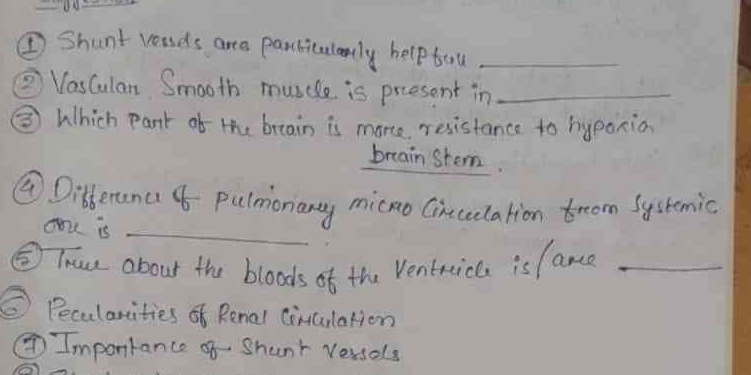1. Shunt vessels are particularly helpful in __________. 2. Vascular smooth muscle is present in __________. 3. Which part of the brain is more resistant to hypoxia? __________. 4.... 1. Shunt vessels are particularly helpful in __________. 2. Vascular smooth muscle is present in __________. 3. Which part of the brain is more resistant to hypoxia? __________. 4. Difference of pulmonary microcirculation from systemic one is __________. 5. Truth about the bloods of the ventricles is __________. 6. Peculiarities of renal circulation __________. 7. Importance of shunt vessels __________.

Understand the Problem
The question is asking about various aspects of human anatomy and physiology, specifically focusing on topics related to circulation, muscles, and brain function. It lists several inquiries that seem to be intended for study or assessment in a medical or biological context.
Answer
1. Temperature regulation, 2. Blood vessels, 3. Brainstem, 4. Lower pressure and resistance, 5. Oxygenated in left, deoxygenated in right, 6. High blood flow and filtration, 7. Bypassing capillary beds.
- Temperature regulation, 2. Blood vessels, 3. Brainstem, 4. Lower pressure and resistance, 5. Oxygenated in left, deoxygenated in right, 6. High blood flow and filtration, 7. Bypassing capillary beds.
Answer for screen readers
- Temperature regulation, 2. Blood vessels, 3. Brainstem, 4. Lower pressure and resistance, 5. Oxygenated in left, deoxygenated in right, 6. High blood flow and filtration, 7. Bypassing capillary beds.
More Information
Shunt vessels are vital for thermoregulation and can redirect blood flow under certain conditions. Vascular smooth muscle is integral for controlling vessel diameter. The brainstem's resistance to hypoxia is crucial for survival.
Tips
It's important not to confuse the roles of the left and right ventricles in terms of oxygenated and deoxygenated blood.
AI-generated content may contain errors. Please verify critical information